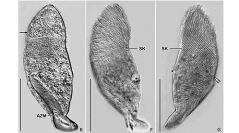

 European Journal of Taxonomy
2020 (697) - Pages 1-46
European Journal of Taxonomy
2020 (697) - Pages 1-46The endozoic ciliates of the family Clevelandellidae Kidder, 1938 typically inhabit the hindgut of wood-feeding panesthiine cockroaches. To assess the consistency of species delimitation in clevelandellids, we tested the utility of three sources of taxonomic data: morphometric measurements, cell geometrical information, and 18S rRNA gene sequences. The morphometric and geometrical data delimited the clevelandellid morphospecies consistently and unambiguously. However, only Paraclevelandia brevis Kidder, 1937 represented a homogenous taxon in both morphological and molecular analyses; the morphospecies Clevelandella constricta (Kidder, 1937) and C. hastula (Kidder, 1937) contained two or three distinct, more or less closely related genotypes each; and the genetic homogeneity of the morphospecies C. panesthiae (Kidder, 1937) and C. parapanesthiae (Kidder, 1937) was not corroborated by the 18S rRNA gene sequences at all. Moreover, the 18S rRNA gene phylogenies suggested the C. panesthiae-like morphotype to be the ancestral phenotype from which all other clevelandellid morphotypes arose. The only exception was the C. constricta-like morphotype, which very likely branched off before the diversification of the C. panesthiae-like progenitor. The present molecular analyses also suggested that a huge proportion of the clevelandellid diversity still waits to be discovered, since examination of only four panesthiine populations revealed 10 distinct clevelandellid genotypes/molecular species.